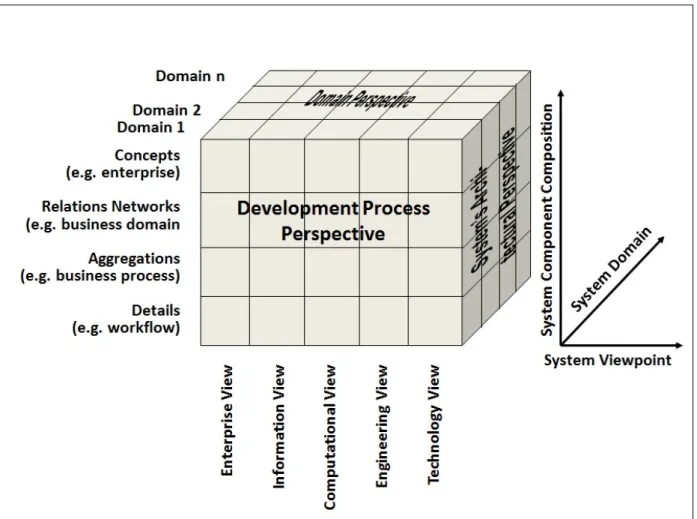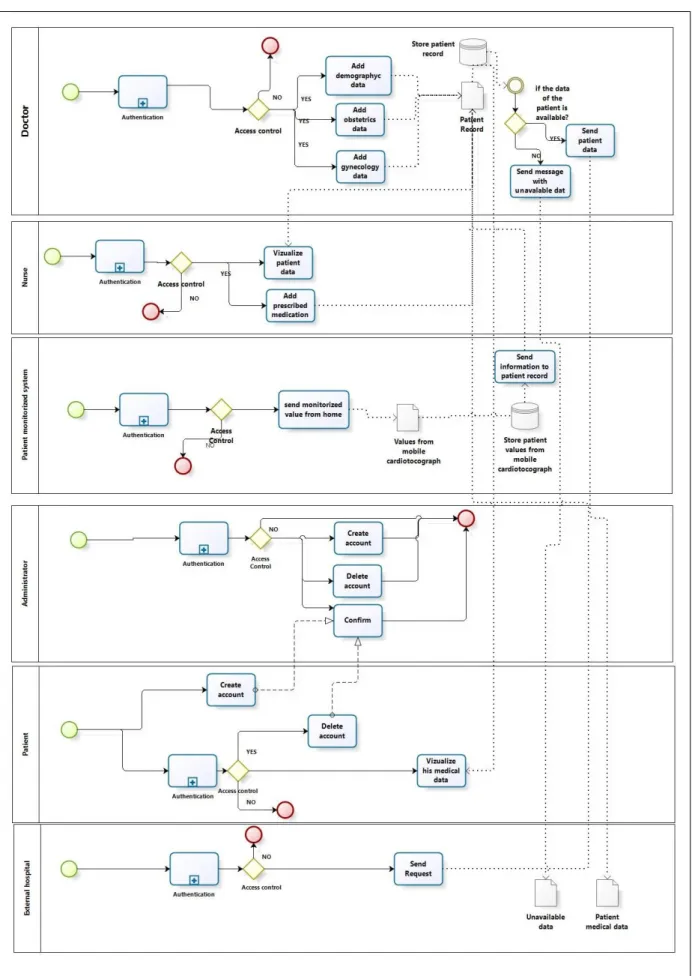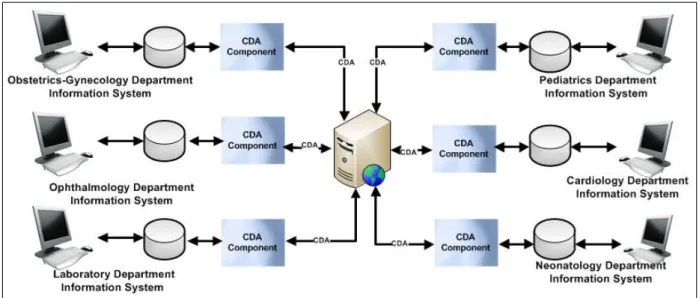Models Supporting Development of Complex Information Systems in Healthcare. Case study: an
Obstetrics-Gynecology Department
Mihaela Crisan-Vida1, Lăcrămioara Stoicu-Tivadar1, Oana Lupse1, Bernd Blobel2, Elena Bernad3
1 Department of Automation and Applied Informatics/University “Politehnica” Timisoara, Romania
2 eHealth Competence Center/University Hospital Regensburg, Regensburg, Germany
3 Department of Obstetrics and Gynecology/University of Medicine and Pharmacy “Victor Babes”, Timisoara, Romania
Abstract
Objectives: The paper presents a framework and tools for developing models useful for implementing complex Infor- mation Systems. It presents a case study for an Obstetrics- Gynecology Department and connected departments. The advantages of using models for creating complex OGD In- formation Systems together with a standardized commu- nication will lead to an advanced interoperability and also will have benefits in patient care and in time will reduce the medical errors.
Methods: This paper presents the modeling process us- ing the Generic Component Model (GCM) in four steps.
The real OGD system is described based on the five RM- ODP (Reference Model of Open Distributed Processing) views. The paper presents the Obstetrics-Gynecology De- partment model based on the real workflow using Business Process Modeling and Notation and a specialized software - Bizagy. Communication between OGD and other medi- cal units is based on HL7 Clinical Document Architecture CDA. The Obstetrics-Gynecology Department Information System (OGD IS) is developed based on the model, in Vi- sual Studio.NET 2010, using ASP.NET pages and C]
language, and Microsoft SQL Server 2008.
Results: The paper presents a model represented with Business Process Modeling and Notation and its possibili- ties to offer support for software developers to create flexi- ble and portable information systems. Based on the work- flow in the OGD, including the communication between OGD and other medical units, was developed a model and consequently the OGD IS.
Conclusions: For the future, the OGD IS will be ex- tended with new functionalities: possibilities to introduce medication related to a Database in the cloud to receive suggested treatments. The advantages of using the OGD IS are reflected in a better patient care, and the treatments will be more documented which will determine less medical errors.
Keywords
Model, Obstetrics-Gynecology Department Information System, HL7 CDA, GCM, model, Business Process Mo- deling and Notation, interoperability
Correspondence to:
Mihaela Crisan-Vida
University “Politehnica” Timisoara, Romania Faculty of Automation and Computers
Address: Bd. Vasile Parvan 2, 300223, Timisoara, Romania E–mail: mihaela.vida@aut.upt.ro
EJBI 2013; 9(1):18–23 recieved: August 21, 2013 accepted: December 1, 2013 published: December 30, 2013
1 Introduction
Interoperability between different medical information systems facilitates access to information and enhances the safety and quality of patient care despite its location. In- formation about patients is available much easier electro- nically and at the same time provides patients and medical professionals with updated and relevant information.
To meet the challenge for efficient, high quality, safe and sustainable care in developing countries, there is a need to extend and improve communication and coope- ration between all actors participating in better patients’
care by creating interoperable health information systems.
Communication between different systems and their components in a complex and highly dynamic environ- ment must fulfill several requirements [1, 2]: openness,
Crisan-Vida et al. – Models Supporting Development of Complex Information Systems in Healthcare
en19
scalability, flexibility, portability; distribution at Internet level; standard conformance; business process orientation;
consideration of timing aspects of data and information exchanged; user acceptance; lawfulness; appropriate secu- rity and privacy services.
The paper [3] presents the possibilities offered by Busi- ness Process Modeling and Notation in healthcare, based on examples. The paper [4] presents a BPMN model for home peritoneal dialysis. The current paper presents the model and for the model based development process for an Obstetrics-Gynecology Department Information System.
An information system in obstetrics – gynecology de- partment is very helpful in maintaining patient data. It is very helpful for medical staff to have information about the patient in real time. Because its specific characte- ristics, it can include medical data, ultrasound analysis, monitored information from pregnant’s lady home and other relevant information about the patient.
The paper presents the possibility to create complex healthcare information systems using models using as case study the current workflow in OGD modeled using Busi- ness Process Modeling and Notation. The communication between OGD and other medical units is ensured using HL7 CDA.
2 The Generic Component Model
The GCM is: “an architecture framework that enables the representation of any real or virtual system; includes the system architecture from its business prospective and the system’s development process for ICT solution sup- porting or enabling that business” [1] which was developed by professor Bernd Blobel from University Hospital Re- gensburg, Regensburg, Germany. The GCM is presented in Figure 1.
The Generic Component Model (GCM) provided the modeling framework for an obstetrics-gynecology depart- ment [5].
The steps reflecting the system development process based on the RM-ODP views are:
• defining the analyzed system, in this particular case the OGD IS,
• separation of the domain of current interest (here the medical one) from other domains which are not relevant for the moment (e.g., financial, administra- tive, security),
• composition/decomposition of the analyzed system, considering four granularity levels (business con- cepts, relations network, aggregations and details),
Figure 1: Generic Component Model.
Figure 2: The real workflow in OGD.
Crisan-Vida et al. – Models Supporting Development of Complex Information Systems in Healthcare
en21
• model-driven development of the real OGD system based on the five RM-ODP views previously men- tioned.
The OGD system is modeled using Business Process Modeling and Notation, and using Bizagy software. The paper [8] presents a previous version of the model of OGD workflow, and the current paper presents a new model which has more actions, including a monitoring compo- nent of the patient status. The OGD IS design and de- velopment process was presented in [6, 7]. For the future new functionalities will be available for the system. The model described in the following represents the Enterprise View.
3 Modeling the
Obstetrics-Gynecology Department
Figure 2 presents the real workflow in the OGD using Business Process Modeling and Notation language using Bizagy Software [8].
The model connects several actors: Doctor, Nurse, Pa- tient, Administrator, Patient monitoring system and Ex- ternal Hospital.
In Process 1 the main actor is the doctor. If he wants to introduce new data about a patient the first step is to authenticate and after the system verifies if the actor has access to introduce new data about a patient, pro- ceeds. In the correct role he/she can input patient data (demographic, gynecology and obstetrics) into a Patient Record (this record is previously created) which has the data stored on a cloud or a server [8].
In Process 2 the main actor is the nurse that has access to the report for patient data and the monitoring report.
She can add information about patient medication admi- nistration. Firstly, she has to authenticate herself and af- ter the system checks that she has the appropriate rights, she can visualize the reports or input information about medication [8].
In Process 3 the main actor is the Patient monitoring system. The hospital can receive information about the patient monitored from home. If the patient monitoring system will send monitored information, the first step for the user is to authenticate himself/herself and after the system verifies if the actor has correct access rights, the data will be received and recorded in Patient Record.
In Process 4 the main actor is the administrator. If changes are needed into the system the first step is au- thentication and after the system verifies if the actor has access, the changes into the system are operated. If the actor has the correct role then he/she has the possibility to create new accounts, delete accounts, to confirm the created or the deleted accounts [8].
In Process 5 the main actor is the patient who can cre- ate a new account after the authentication and the system verifies if the actor has access. If the actor has the correct
role then he/she can express the will to delete an account or request a report about monitored information about the pregnancy [8].
In Process 6 the main actor is an external hospital which requests data about a patient. Firstly, it has to authenticate and the system checks the rights and if they are correct sends a request to OGD. If he has rights to access the information and if the information is available, the OGD IS will send an XML in HL7 CDA format or in the case if the information are not available than the ex- ternal hospital will receive a message were will be written that the information about the patient requested are not available [8].
4 Obstetrics-Gynecology
Department Information System
OGD IS is an application developed in Visual Stu- dio.NET 2010, using ASP.NET and C] language. The database is using Microsoft SQL Server 2008. In the fu- ture the system will provide the possibility to receive data from systems which are for monitoring the patient from home (a mobile cardiotocography will give the possibility to send information about the pregnant woman to the doc- tor). There will be available a possibility to send patient medication to a database in a cloud connected to an ap- plication suggesting treatments based on previous doctors experience. The current doctor will have the possibility to choose that treatment or not.
Figure 4 presents an image from OGD IS where the doctor can add a consultation regarding gynecology data.
Figure 3 presents a screen shot from Obstetrics- Gynecology Department Information System where the doctor can add information about the examination.
Figure 3: Entering system examination.
It is important that the OGD IS has the possibility to communicate with other medical units, based on im- plemented interoperability between medical information systems. Figure 5 presents the communication framework between the OGD IS with other medical units.
To achieve interoperability we use XML files based on HL7 CDA standard. An example is in the case of OGD IS and Pediatrics Department communication. When the data of a new born child is added in the database of the
Figure 4: Entering gynecology data.
pediatrician, the physician will be asked if he/she wants to add the data manually or retrieve it from the database of the hospital, which technically is located in the server or private cloud of the Obstetrics and Gynecology unit, where the baby was born. When the data acquisition from the Obstetrics and Gynecology unit option is cho- sen, the Pediatrics application will create an XML file with the Personal Identification Number of the mother, date of birth of the child. The XML file with these data will be sent to the data server from the private cloud of the unit of Obstetrics and Gynecology. When these dates are available in the server, via a specific application it will check the validity of the received message will analyze the request and if the data exists in the server the application will form another XML file which contains the medical data record of the baby from birth until to the day of dis- charge. These XML file is created in HL7 CDA standard
format, and it will be sent to the unit who requested the data [9].
Once received, the required medical data in XML for- mat, the Pediatrics application will read the XML file and will display the medical records to the location point where the physician adds the patient. The received medi- cal data will be saved in the database server of the private cloud of the Pediatrics unit. The pediatrician will have access to the medical history of the baby from birth and during pregnancy, information important for monitoring and treating the child [9].
In Figure 3 the communication is realized using web server, but in the future will be uploaded in the cloud. The advantage of using the cloud solution is that information is always and anywhere available.
Applications communicate with each other better and more effectively using the HL7 CDA standard, due to its
Figure 5: Communication between OGD IS and other medical units.
Crisan-Vida et al. – Models Supporting Development of Complex Information Systems in Healthcare
en23
features structuring the medical data on several levels and with certain codes that can be read by any application that uses these medical standards [9].
5 Conclusions
The paper presents the possibility to create complex healthcare information systems using models. It presents a case study for OGD IS modeled using Business Process Modeling and Notation with its processes. [8] presents a previous version of the model for the OGD workflow, and this paper presents a newer version which brings more ac- tions related to the OGD. Based on the previous model the OGD IS basic system was developed, and in the fu- ture the new actions described by this paper model will be implemented. The communication between OGD IS and other medical units is using HL7 CDA with examples pre- sented in the paper. A new component that will be added in the future is the possibility to use a specialized software tool that has as functionalities receiving treatments from different specialist from different locations and checking between given treatments, and suggesting a treatment.
The doctor may or may not use the suggestion, having the possibility to approve it or not.
The paper [10] presents the steps and metrics for eva- luating the interoperability of an Obstetrics-Gynecology Department Information System used in this paper and applied in Bega Clinic Timisoara regarding its readiness for interoperability in relation with similar systems. [10]
presents also the amount of data related to the current system exchanged between the Obstetrics-Gynecology De- partment and other medical units. The obtained results were relatively good for the investigated data and struc- ture of the system.
The work presented in this paper prepares a frame- work for flexible and quick development of OGD infor- mation systems supported by increased interoperability.
Using the OGD IS medical staff will have a support for better patient care, the access to patient information will be in real time in the case of an emergency.
Using models before implementing an application im- proves the quality of the software, increases development
speed, leads to a better maintainability and reusability, and also ensures better portability and interoperability.
References
[1] B. Blobel, Advanced EHR architectures—promises or reality, Methods Inf. Med. 2006; 45 (1): 95–101.
[2] Lopez D., Blobel B. A development framework for semanti- cally interoperable health information systems. International Journal of Medical Informatics 2009; 78:83-103
[3] M. Richard and A. Rogge-Solti, BPMN for Healthcare Pro- cesses, CEUR Workshop Proceedings, Vol. 705, 2011 [4] Monteleone, Home Peritoneal Dialysis: a BPMN
model and use of 5S principles, Available on:
http://www.modernanalyst.com/Resources/Articles/tabid /115/articleType/ArticleView/articleId/2650/Home- Peritoneal-Dialysis-a-BPMN-model-and-use-of-5S- principles.aspx
[5] Lopez D. and Blobel B. Formal Design of Electronic Public Health Records, Medical and Care Compunetics 3, 2006 [6] M. Vida, O. Lupse, L. Stoicu-Tivadar, V. Stoicu-Tivadar, ICT
Solution Supporting Continuity of Care in Children Health- care Services, 6th IEEE International Symposium on Applied Computational Intelligence and Informatics, SACI, 2011, 635- 639
[7] O. Lupse, M. Vida, L. Stoicu-Tivadar, V. Stoicu-Tivadar, Us- ing HL7 CDA and CCD standards to improve communica- tion between healthcare information systems, 9th IEEE Inter- national Symposium on Intelligent Systems and Informatics, SISY, Serbia, 2011, 435-457
[8] M. Vida, L. Stoicu-Tivadar, B. Blobel, E. Bernad, Modeling the framework for obstetrics-gynecology department informa- tion systems, IHIC Conference, 2012, published in European Journal for Biomedical Informatics Vol. 8, Issue 3 “Standard and Solutions for ehealth Interoperability of the European Journal of Biomedical Informatics”, 2012
[9] O. Lupse, M. Vida, L. Stoicu-Tivadar, Cloud Computing and Interoperability in Healthcare Information Systems, Proc. The First Internatonal Conference on Intelligent Systems and Ap- plications, INTELLI2012, Chamonix, Franta, pp. 81- 85 [10] M. Vida, L. Stoicu-Tivadar, B. Blobel, E. Bernad, Interoper-
ability Evaluation Case Study: An Obstetrics-Gynecology De- partment and Related Information Systems, Studies in Health Technology and Informatics, Volume 186: Data and Knowl- edge for Medical Decision Support, pp. 177 - 181


![Figure 2 presents the real workflow in the OGD using Business Process Modeling and Notation language using Bizagy Software [8].](https://thumb-eu.123doks.com/thumbv2/1library_info/5652411.1693964/4.892.477.834.778.974/presents-workflow-business-process-modeling-notation-language-software.webp)
